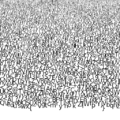Texture atlas
In realtime computer graphics, a texture atlas (also called a sprite sheet) is an image containing a collection of smaller images, usually packed together to reduce the atlas size. Atlases can consist of uniformly-sized sub-images, or they can consist of images of varying dimensions. A sub-image is drawn using custom texture coordinates to pick it out of the atlas. In an application where many small textures are used frequently, it is often more efficient to store the textures in a texture atlas which is treated as a single unit by the graphics hardware. Careful alignment may be needed to avoid bleeding between sub textures when used with mipmapping and texture compression.
Gallery
 A texture atlas for a video game
A texture atlas for a video game A texture atlas of glyphs
A texture atlas of glyphs Sprite sheet for the video game, Blades of Exile
Sprite sheet for the video game, Blades of Exile
External links
Explanations and algorithms
- Texture Atlas Whitepaper - A whitepaper by NVIDIA which explains the technique.
- Practical Texture Atlases - A guide on using a texture atlas (and the pros and cons).
- A thousand ways to pack the bin - Review and benchmark of the different packing algorithms
- Sprite Sheets - Essential Facts Every Game Developer Should Know - Funny video explaining the benefits of using sprite sheets
Tools
- TexturePacker - Commercial texture atlas creator for game developers.
- LibGDX texture packer - Open source texture packer utility from libGDX
- Texture Atlas Maker - Open source texture atlas utility for 2D OpenGL games.
- SpriteMapper - Open source texture atlas (sprite map) utility including an Apache Ant task.
This article is issued from
Wikipedia.
The text is licensed under Creative Commons - Attribution - Sharealike.
Additional terms may apply for the media files.